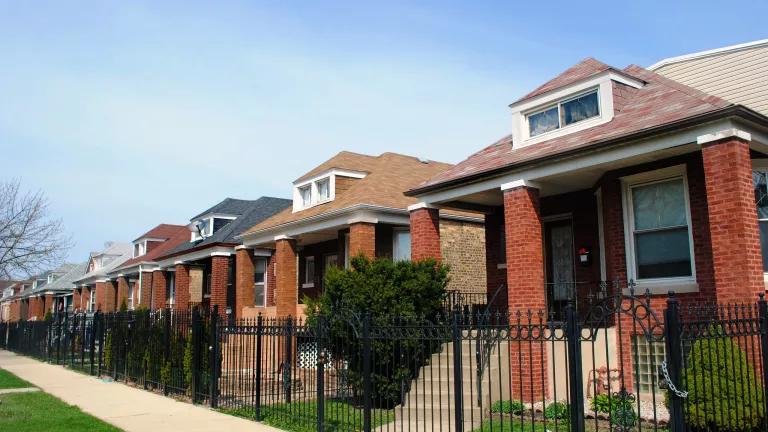Building Electrification: The Future of Home Energy
Illinois deserves better options when it comes to heating our homes. Building electrification is a cost effective and safe alternative to the gas system.

Bungalows in Chicago's neighborhood of Hermosa
Illinois’ three major gas utilities requested to raise rates this January to the tune of $900 million at a time when a significant portion of Illinoisans are struggling to pay their utility bills. Gas utilities are trying to extract more money from their customers to build their increasingly expensive and dirty system. If approved, this record-high-rate increase will hurt the public and our planet. We must transition to a cleaner and cheaper way to heat our homes.
To meet our climate goals, we must scale down our state’s gas system. Luckily, we have a cost-effective alternative to the gas system—building electrification. Building electrification is the process of moving away from the gas system by powering our homes with electric appliances. Electrification can help buildings become more energy efficient and less polluting as the electric grid becomes cleaner. Building electrification will transform how we power our homes and transition us off the dirty gas system. This transition frightens the gas utilities.
Despite the gas utilities’ best marketing efforts and fearmongering, the gas system is undergoing a transformation. Gas utilities cannot press forward with “business as usual” spending for three main reasons: 1) residents cannot afford their ever-increasing gas bills, 2) building electrification is a reliable and cheaper alternative to the gas system, and 3) Illinoisans will almost certainly use less gas in the future.
Gas Utilities Put a Strain on Illinoisans’ Budgets
Illinois has an energy affordability crisis. Census data from February 2023 showed a glimpse of this crisis. The report found that 18.2% of Illinois households keep their homes at an unsafe temperature, and 19.6% were unable to pay their energy bill in full. Too many Illinoisans have to choose between paying their gas bill or purchasing necessities such as food or medicine. But when many Illinoisans are struggling, gas utilities want more.
Utilities like Peoples Gas are driving the gas affordability crisis in Illinois. Despite making record profits in 2022, Peoples Gas has one of the highest customer charge in the Midwest. Before even using a single bit of gas, Chicagoans must pay Peoples Gas around $380 each year to upkeep their system. That number will jump to over $500 if Peoples’ rate proposal is approved, exacerbating energy burdens for people who already cannot afford their gas bill. This burden is not felt equally among Illinoisans. Communities of color often experience higher energy burdens and shutoffs due to systematic inequities in our society. While Peoples Gas has pocketed record profits, communities on the South and West sides of Chicago are disproportionately struggling.
The facts are clear—Peoples Gas customers pay some of the highest gas prices in the Midwest, much of which is the result of the company’s irresponsible spending and the inherent volatility of gas prices. Despite this volatile landscape, Peoples gas is asking customers for more money, further worsening the energy affordability crisis for Illinois residents.
A Way Out From Under: Building Electrification
Residents being squeezed by skyrocketing gas bills deserve better energy options. Electrification is a cost-effective alternative to using gas in the Peoples Gas territory given the volatility of gas prices and the ever-increasing expense of gas pipeline infrastructure.
Testimony from Energy Futures Group (“EFG”) in the Peoples Gas rate case currently before the Illinois Commerce Commission presents robust analysis of the cost-savings potential of electrification for the average residential building in Chicago. Customers who live in a single-family home will see cost savings in the very first year after transitioning to all-electric heating. Financial incentives in the Inflation Reduction Act (IRA) will create even more savings for the folks that want to electrify their homes. The benefits of electrification are even greater for newly built homes. An RMI study found that installing a heat pump instead of a gas-powered furnace in a new home will save residents $4,000 over the lifetime of the appliance.
Illinoisans Are on Track to Use Less Gas in the Coming Years
Gas utilities draft their proposal for rate increases based on a variety of factors, including gas use and cost to maintain their system. A proposed increase must accurately forecast how much gas its customers will use in the future, which in turn determines the necessary investments needed to meet their customers’ needs. Utilities often argue that their customers will continue to use gas at the same rate or increase their usage over the next few years in order to justify a proposed rate increase. This flawed argument not only cost customers more on their monthly gas bill but will lead to utilities investing in a dirty system that will become obsolete in the coming years.
Illinoisans are making it clear they support policies that decrease our dependence on gas and combat climate change. To meet our state commitment of net zero emissions by 2050, which is necessary to avoid the most catastrophic climate events, we must cut emissions from our homes and buildings. State and local municipalities are paving the way, proposing innovative solutions to slash emissions from buildings.
At the state level, the Climate and Equitable Jobs Act (“CEJA”) allowed for the adoption of stretch codes in certain municipalities to allow cities to pass stronger building codes that will limit energy usage. Some of these codes include phasing out gas in new construction. In fact, just recently, Oak Park used this provision to require new construction to be all-electric. Oak Park officials cite this as aiding in its efforts of reaching net zero carbon emissions by 2050. As these policies become more common, gas usage will decline.
Another example is the City of Chicago’s recent announcement for residential electrification projects. The City’s Department of Housing plans to invest deeply in low-income communities and will provide “grants that may be used for weatherization, energy efficiency, and electrification of household systems.” Further, the program aims “to deepen the bench of local contractors with the skills and experience to install cutting-edge, energy efficient equipment…” Mayor Johnson described the program’s purpose to “catalyze our efforts to provide critical solutions for residents on the frontlines of the climate crisis as we take a leadership role citywide in reducing our dependence on fossil fuels.” Cities around the country are undertaking similar initiatives to move away from the gas system.
Gas utilities can no longer hide behind the argument that there is uncertainty surrounding the impacts of electrification on the gas system and therefore, it is not necessary to consider electrification when planning for future upgrades to the gas system. In fact, a report commissioned by Ameren proves why a utility should consider electrification when proposing expensive upgrades to its system because those investments might become useless in the future.
In Ameren’s report, the Electric Power Research Institute (“EPRI)” analyzed multiple scenarios of the adoption of electric technologies in the utility service territory for three sectors including buildings. The study found that natural gas consumption in buildings is projected to decrease between 38% and 56% in Ameren’s service territory by 2050. Meaning, we must rein in the irresponsible spending on long-lived investments in light of this decrease gas usage.
With Proper Planning, The Electrical Grid Is Ready to Take on Building Electrification
Transition—that is the key word in the discourse surrounding grid capacity and building electrification. Advocates are not asking utilities and the public to suddenly abandon the gas system overnight. The grid would struggle to cope with a rapid and unplanned increase in demand without time to implement critical upgrades to modernize our electric system for the future of building electrification. What we are advocating for is to start planning for the transition away from a gas system that pollutes our homes and is detrimental to our health. The real question is can the electric grid support the increase demand as we transition to the future, and the answer is yes.
Electrification will have a dynamic impact on the grid, but by utilizing energy efficient technologies and smart planning, our power system can accommodate increased electricity demand.
Energy efficient equipment and building envelope improvements will play a huge role in this transition. It is a simple concept: we need appliances and equipment capable of doing more with less energy. Fortunately, the new generation of electric-powered appliances are up to the task. For instance, electric air sourced heat pumps are vastly more efficient than traditional air conditioning units. Heat pumps also provide heating in the winter and are more than twice as efficient as gas furnaces. All regions of the country benefit from these efficient appliances. Cold-climate heat pumps are now capable of providing efficient power in below freezing temperatures. In fact, people as far north as Alaska are using cold climate heat pumps to power their homes. As the market for these technologies increase due to policy changes and financial incentives from the IRA, we will need less energy to heat and cool our homes. Reducing energy demand is a key component to future electricity grid planning.
Illinois electric utilities and regional grid operators have already begun planning for increased electricity demand. Under CEJA, major utilities must submit distribution system plans that account for Illinois’ clean energy transition. Commonwealth Edison (“ComEd”) and Ameren submitted their initial plan this January. Ameren and ComEd both cited that their plans outline investments necessary to support a clean energy transition. Further, ComEd articulates that its “investment in its system over the past decade …. has laid the foundation to support Northern Illinois’ transition to a decarbonized energy economy.” This process has directed Illinois’ utilities to begin planning for a decarbonized future, which will include more all-electric buildings.
Conclusion
Efficient, electric appliances are the best way to power Illinois’ homes and buildings for an affordable, clean energy future. We cannot allow Illinois’ gas utilities to undermine our state’s climate goals with continued investments in their dirty fuel sources. Regulators should not greenlight any irresponsible investments beyond what is necessary to maintain a safe gas system with the backdrop of transitioning off the gas system. Instead, utility regulators should pursue building electrification as a cost-effective alternative to the outdated gas system.



